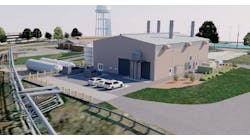Washington State is getting greener now that the Snohomish County Public Utility District is building a microgrid powered by a 500-kW solar array, which will use lithium-ion battery storage and provide backup power in case of an emergency.
The project, which should be ready for testing late in 2020, will cost $12 million and it will receive a grant from the state of $3.5 million. The Arlington Microgrid and Clean Energy Technology Center project aims to leverage battery technology to provide backup power as well as peak shaving and the integration of renewable energy and electric vehicles.
“We are connected to the grid,” says project manager Scott Gibson, in an interview. “But if there is an earthquake we disconnect from the grid and our microgrid will power up our future local office building. A lithium-ion battery (1,000 kW/1,000 kWh) and a solar array will keep that powered instead of a diesel generator that uses fossil fuels.”
The contract to build the solar array was awarded to A&R Solar of Seattle.
After the project is tested, the ultimate goal is to look for other opportunities to expand the technology in the utility’s service territory. And right now, the batteries do not pay for themselves, although their prices are dropping by 10% a year. If the utility can get multiple uses from the devices — backup power, renewable energy integration and peak shaving to preserve the main grid — their benefits will add up.
To that end, the utility sees renewable energy as its future. Already, it relies on hydropower for 85% of its electricity. But coal and natural gas do have small roles through market purchases. The utility district wants to minimize their usage, necessitating that it be able to integrate more wind and solar onto the grid. One way the utility district can get close to achieving that goal is through the confluence of on-site generation and energy storage, or more microgrids.
“With all of the recent natural disasters, communities across the United States are realizing that microgrids can keep the lights on,” says Gibson, adding that microgrids will become more mainstream as solar and battery prices continue to fall. “People are starting to think that solar-plus-battery can be used as backup power.” Solar-plus-storage does not face the potential supply disruptions of fossil fuels during emergencies and at times when the roads may be hard to traverse.
The microgrid, futhermore, will incorporate a few electric fleet vehicle charging stations referred to as vehicle-to-grid. Those charging stations can power up a car as well as allow for the energy stored in the electric vehicle to flow back to the grid and provide support during an outage.
The Snohomish County Public Utility District is contracting with Mitsubishi Electric for the equipment for the vehicle-to-grid system and Nissan for the electric vehicles. It is also working with the University of Washington to study the economics of microgrids, energy storage, solar in the Pacific Northwest, and the feasibility of using vehicle-to-grid technology.
Track news about utility microgrids. Subscribe to the free Microgrid Knowledge newsletter.






